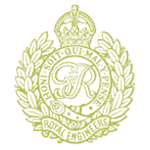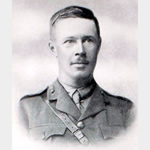Commemorated: | |||
| 1. Memorial: | Paines Lane Cemetery, Pinner, Harrow | E. 75. | |
| 2. Book: | The (1921) Masonic Roll of Honour 1914-1918 | Pg.130 | |
| 3. Memorial: | The (1940) Scroll - WW1 Roll of Honour | 45D GQS | |
Awards & Titles: | |||
Family :
Son of H. W. and Frances Emily Miller; husband of Rosa Gwendoline Miller, of Chestnut Conage, Pinner.Portrait photo courtesy of the IEE Archives, as is the pen picture below.
Service Life:
Campaigns:
- The First World War 1914-1918, World-wide.
| Unit / Ship / Est.: Royal Engineers |
| Action : France & Flanders |
France & Flanders covers all the dates and corresponding locations which are outside the official battle nomenclature dates on the Western Front. Therefore the actions in which these men died could be considered 'normal' trench duty - the daily attrition losses which were an everyday fact of duty on the Western Front.
Detail :
"SECOND-LIEUTENANT F.S. MILLER, ROYAL ENGINEERS (Territorial Force)
"FRANCIS SAMUEL MILLER was the eldest son of Horace William Miller, Lamp Manufacturer, and of Emily Frances, his wife, of Manor House, Old Malden; Surrey (b. at, Old Malden, September 24, 1877). He was educated at Mr, Price's School, Brighton, Sussex (1885—1890), and at St. Paul's School. London (1890-1896), which he entered with a Junior Scholarship. He became a Senior Scholar of St. Paul's School and, in 1899, won the Smee Prize. He entered the City and Guilds. Central Technical College (now the City and Guilds (Engineering) College), South Kensington, in September, 1896, and took the three ' years course in electrical engineering under Professor W. E. Ayrton, F.R.S., President I.E.E., 1892. On the completion of his course, he was awarded the Diploma of an Associate of the City and Guilds of London Institute.
He was engaged in June, 1899, as a Draughtsman, by The Potteries Electric Traction Company, Ltd., of Stoke-upon-Trent, Staffs, and, after serving in that position for four months, was appointed Mains and Distribution Superintendent, a position in which he served for two years : he was then appointed Construction Assistant and placed in charge of work in connection with the extension Of the Company's mains. He resigned his position with this Company in October, 1903, and entered the service of The Saunderson Tractor and Implement Company, Ltd., of Bedford, as an Assistant Engineer, and was employed in the Company's Elstow Engineering Works until the end of 1904, when he gave up his appointment in order to join his father's firm.
He became a Director Of Messrs, Miller & Sons. of New Burlington Street, London, in December, 1904. and was holding this position when war was declared in 1914; he temporarily relinquished the duties of his office in the summer of 1915, in order to serve in the Army.
He was given a Commission in the Royal Engineers (T.F.) in July. 1915, rand posted to the 2/1st Wessex Field Company, stationed, at the time at Ilford Camp, Essex. He was sent to the Engineering Training Centre established at Deganwy, North Wales, and put through the special course of military training provided there for officers of the New Army. He subsequently served for some months at Home with his Company, which was, one of the Engineer units of the 58th (2/1st London) Division, and later, on the re-organization of Royal Engineers of the Territorial Force, became the 503rd Field) Company. His Division, was ordered to France. towards the end of and, began to cross, the Channel on January 20, 1917; he left for the Front the 23rd idem with his Company. The Division assembled near Doullens, in Third Army area. and its units were, before taking a tour of duty in the line, first attached to those of formations which had already had experience of trench-warfare, and spent short periods with them in order to be initiated into being pursued at the time in meet what exceptional situation at the Front.
Soon after its arrival at the Front, his Division came under the XVIII Corps, then holding the section of the line, on the extreme right Of the Third Army front; extending from near Riviére to Gommecourt. After spending short periods successively in the neighbourhood of Barly; Lucheux and Pommera, the Division, during the third week of February, relieved the 49th (West Riding) Division in the line; it then had the 30th (County Palatine) Division on its left and the 46th (North Midland) Division on its right. Shortly afterwards a reorganization of the Third Army front out and the frontage of the XVIII Corps contracted to the section of the line held by his Division. About this time the Division went into the line, the Germans began to fall back to the Hindenburg Line from a point southward Of Arras; thereupon British and French troops took up the pursuit the retreating enemy. Soon after the German retreat commenced, a further re-organization of the Third Army front was carried out and the VII Corps now extended its right so as to include in its line the section of trenches held by his Division, and the XVIII Corps thereupon went into reserve. At the end of March, his Division was withdrawn from the line and to Bonniére (about 7 miles north-west of Doullens). In the meantime. the British Commander-in-Chief had collected a striking force opposite the point of junction of the Old and new German fronts with a view to striking a blow (The Battles of Arras, 1917-—April 9—May 4) against the section of line stretching from Lens to Arras, a front oi over 12 miles. A powerful concentration of artillery had been effected on this front and considerable preparations had to be made by the Royal Engineers in connection with this offensive; his Company contributed its share to the work.
Just before the offensive was launched from the Arras Sector, his Division was moved south to Bertrancourt in the Fifth Army area and came under the V Corps; it later spent short periods in and about Miraumont and Bihucourt. On April 23, there was a renewal of the advance (Second Battle of the Scarpe, 1917—April 23—24) all along the British Front, and five days later an attack (Battle of Arleux—Apri1 -28—29) was delivered north of the Scarpe between Acheville and Roeux, from the right front of the Third Army. On May 3, another offensive (Battle of Bullecourt—May 3—17) was launched, further south, against the Hindenburg Line from the front of the Fifth Army, when the divisions Of the V Corps provided the assaulting troops. Towards the close of the Battle of Bullecourtt his Division relieved the 7th Division on the right front of the V Corps and came into immediately to the north of Écoust His then had the 62nd (2/1St West Riding) on its left and the 5th Australian Division (I Anzac Corps) on its right, this period, he was constantly employed with, his Company on work in connection with the of the positions held by the units of his Division, and be was often engaged upon duties involving considerable personal danger. He was on the night of May 20—21 detailed to some work which had to be carried out by his Section near Bullecourt; while so engaged, he was hit and dangerously wounded. He was conveyed to a casualty clearing station, and on June 6 invalided Home. On arrival in London, he was admitted into the Sussex Hospital, Regent's Park, where, on the day following, he was found to be suffering from gangrene; it became necessary at once to amputate his leg. The operation was accordingly carried out, but he was at the time in a very weak condition and never recovered from the shock to his system, passing away the same evening.
Age : 39 years 8 months.
His Company Commander wrote :—
"He was such a support to me; in every way he helped, always reliable and cheerful, a thoroughly conscientious officer, and a true friend. "He gave all his energies to his duty, never faltering ; he gained the respect of everyone came in contact with, and especially 'the love is personal friend< and men."
He married at St. Martin's Church, Bedford, on September 23, 1911, Rosa Gwendoline, the second daughter of Charles Lewis Packe, of 59, Chaucer Road, Bedford; he is survived by his widow. He took a considerable interest in Freemasonry and was initiated into the mysteries of the Craft in the New Century Lodge, No. 2860, on June 6, 1913; he took a final step on January 14, 1914.
Institution record; Student, 1898; Associate, 1901; Associate Member, 1903."
See also: IEE Archive.
Masonic :
| Type | Lodge Name and No. | Province/District : |
|---|---|---|
| Mother : | New Century No. 2860 E.C. | London |
Initiated | Passed | Raised |
2nd June 1913 | 11th December 1913 | 14th January 1914 |
Three years of war service recorded before the final annotation of "Died June 1917."
Source :
The project globally acknowledges the following as sources of information for research across the whole database:
- The Commonwealth War Graves Commission
- The (UK) National Archives
- Ancestry.co.uk - Genealogy, Family Trees & Family History online
- ugle.org.uk - The records of the United Grand Lodge of England including the Library and Museum of Freemasonry
Additional Source:
- Founder Researchers : Paul Masters & Mike McCarthy
- Researcher : Bruce Littley

